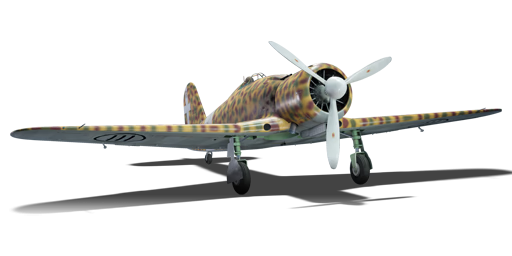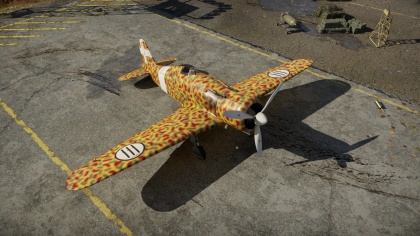G.50 AS serie 7 (Germany)
Contents
| This page is about the fighter G.50 AS serie 7 (Germany). For the Italian version, see G.50 AS serie 7. For other uses, see G.50 (Family). |
Description
The ▀G.50 Freccia AS serie 7 is a rank I gift German fighter
with a battle rating of 2.0 (AB/SB) and 1.7 (RB). It has been in the game since the start of the Open Beta Test prior to Update 1.27 in the German aviation tree. In Update 1.69 "Regia Aeronautica", the G.50, as well as the other Italian planes in the German tech tree, were moved to the new Italian tree, although it still exists in the German tree for those who unlocked it prior to Update 1.69.
The Fiat G.50 is the oldest of the Series 0 planes, its fellow stablemates are the M.C 200 and Re 2000, both built around the same 860 HP radial engine and having the same armament.
General info
Flight performance
Describe how the aircraft behaves in the air. Speed, manoeuvrability, acceleration and allowable loads - these are the most important characteristics of the vehicle.
| Characteristics | |||||||
|---|---|---|---|---|---|---|---|
| Stock | |||||||
| Max Speed (km/h at 5,000 m) |
Max altitude (meters) |
Turn time (seconds) |
Rate of climb (meters/second) |
Take-off run (meters) | |||
| AB | RB | AB | RB | AB | RB | ||
| 451 | 435 | 8200 | 15.9 | 16.6 | 7.4 | 7.4 | 318 |
| Upgraded | |||||||
| Max Speed (km/h at 5,000 m) |
Max altitude (meters) |
Turn time (seconds) |
Rate of climb (meters/second) |
Take-off run (meters) | |||
| AB | RB | AB | RB | AB | RB | ||
| 492 | 470 | 8200 | 14.1 | 15.0 | 14.1 | 10.3 | 318 |
Details
| Features | ||||
|---|---|---|---|---|
| Combat flaps | Take-off flaps | Landing flaps | Air brakes | Arrestor gear |
| ✓ | ✓ | ✓ | X | X |
| Limits | ||||
|---|---|---|---|---|
| Wing-break speed (km/h) |
Gear limit (km/h) |
Combat flaps (km/h) |
Max Static G | |
| + | - | |||
| 600 | ~13 | ~5 | ||
| Optimal velocities | |||
|---|---|---|---|
| Ailerons (km/h) |
Rudder (km/h) |
Elevators (km/h) |
Radiator (km/h) |
| < 360 | < 270 | < 500 | > 300 |
| Compressor (RB/SB) | ||
|---|---|---|
| Setting 1 | ||
| Optimal altitude | 100% Engine power | WEP Engine power |
| 3,800 m | 815 hp | 957 hp |
Survivability and armour
Examine the survivability of the aircraft. Note how vulnerable the structure is and how secure the pilot is, whether the fuel tanks are armoured, etc. Describe the armour, if there is any, and also mention the vulnerability of other critical aircraft systems.
Armaments
Offensive armament
The G.50 AS serie 7 (Germany) is armed with:
- 2 x 12.7 mm Breda-SAFAT da 12.7 mm machine guns, nose-mounted (300 rpg = 600 total)
Suspended armament
The G.50 AS serie 7 (Germany) can be outfitted with the following ordnance:
- Without load
- 2 x 50 kg GP 50 bombs (100 kg total)
Usage in battles
In general, it is a slightly worse version of the M.C 200, and as such, it very much flies the same, albeit a little bit slower. With its decent rate of climb, it's generally best to ensure you have proper altitude to play around with first. Generally for low tier planes like the G.50, 3000 - 4000 meters is generally enough, from there, the way of flying should be dedicated by the situation and opponents. Its good acceleration in dives and respectable dive speeds means it can be used as a pure Boom and Zoomer, especially when you realise its energy retention is better than that of many other planes at its BR. However, it is a decent turn-fighter, barring the poor acceleration so it can be used as such as well. Be careful against regular biplanes and Japanese monoplanes, both of which are considerably better, bar high speeds, where the stiffness of controls on the G.50 are less than on either biplanes or Japanese planes.
The Fiat G.50 Freccia is a typical Italian pre-war design, it's fairly sturdy, has modest speed and poor armament consisting of 2 Breda SAFAT 12.7mm guns mounted in the upper cowling, which means it has the distinctive low rate of fire (roughly 400 rounds per minutes). However it does have its merits as well, it's fairly agile, it has no trouble dogfighting Hurricanes it will commonly face, and if things become too hectic, the G.50 can quickly escape by going into a dive, and exploit its surprisingly good dive acceleration to gain separation. Furthermore, it pays to be aware of its modest acceleration and overheating, as such, it's generally advised to maintain an eye on your speed and use WEP sparingly.
For the armament, the same applies to all other Italian aircraft; generally, you want to use Tracers, Air targets or Stealth since they are the belts that deal the most damage. Shell velocity is low, hence they suffer above 300 meters, so only fire at or below that range for best effects. Furthermore, much like the other Italian fighters, the armament is woefully inadequate to deal with bombers, hence it is best to avoid them entirely, or focus on taking out the engines. The only exceptions are the very early biplane bombers, such as the Swordfish, Po-2 and the likes.
Manual Engine Control
| MEC elements | ||||||
|---|---|---|---|---|---|---|
| Mixer | Pitch | Radiator | Supercharger | Turbocharger | ||
| Oil | Water | Type | ||||
| Controllable | Not controllable Not auto controlled |
Controllable Not auto controlled |
Controllable Not auto controlled |
Separate | Not controllable 1 gear |
Not controllable |
Modules
| Tier | Flight performance | Survivability | Weaponry | ||
|---|---|---|---|---|---|
| I | Fuselage repair | Radiator | Offensive 12 mm | ||
| II | Compressor | Airframe | MCGP50 | ||
| III | Wings repair | Engine | New 12 mm MGs | ||
| IV | Engine injection | Cover | |||
Pros and cons
Pros:
- Good visibility from the cockpit
- Decent rate of climb
- Good acceleration in a dive
- High maximum dive speed
- Decent high-speed handling
- Good dogfighter
Cons:
- Modest armament
- Poor acceleration in level flight
- Overheating is an issue
- Guns deal very little damage at long range
- Modest speed
History
Describe the history of the creation and combat usage of the aircraft in more detail than in the introduction. If the historical reference turns out to be too long, take it to a separate article, taking a link to the article about the vehicle and adding a block "/ History" (example: https://wiki.warthunder.com/(Vehicle-name)/History) and add a link to it here using the main template. Be sure to reference text and sources by using <ref></ref>, as well as adding them at the end of the article with <references />. This section may also include the vehicle's dev blog entry (if applicable) and the in-game encyclopedia description (under === In-game description ===, also if applicable).
In-game description
The G.50 Freccia (“Arrow”) was the first Italian all-metal monoplane fighter, which, although clearly inferior to allied fighters of the time, was the best Italian fighter aircraft.
Development of the fighter began in 1936, at the request of the Italian Air Force, and ended with the creation of an easy-to-manage and extremely manoeuvrable interceptor. The "Arrow" used such modern technology as a constant-speed all-metal propeller and variable pitch, as well as retractable landing gear. The “Arrow,” however, could not take advantage of the monoplane design because its engine was too weak (at 840 horsepower). The aircraft’s limited armament was also a weakness - it had two synchronous large-calibre machine guns with 150 rounds of ammunition.
The first series of 45 G.50s, production of which began in late 1937, had a closed cockpit, and while it provided relatively good visibility, the pilots were not very enthusiastic about it, so the second series of planes (200 aircraft) was built with an open cockpit. All in all, 833 G.50s were build (including all variants).
Besides Italy, the plane served in Finland, Croatia, and Spain as well.
Media
Excellent additions to the article would be video guides, screenshots from the game, and photos.
See also
Links to the articles on the War Thunder Wiki that you think will be useful for the reader, for example:
- reference to the series of the aircraft;
- links to approximate analogues of other nations and research trees.
External links
Paste links to sources and external resources, such as:
- topic on the official game forum;
- encyclopedia page on the aircraft;
- other literature.
| Germany fighters | |
|---|---|
| Heinkel | |
| He 51 | He 51 A-1 · He 51 B-1 · He 51 B-2/H · He 51 C-1 · He 51 C-1/L |
| He 100 | He 100 D-1 |
| He 112 | He 112 A-0 · He 112 B-0 · He 112 B-1/U2 · He 112 B-2/U2 · He 112 V-5 |
| Messerschmitt | |
| Bf 109 (Jumo) | Flegel's Bf 109 A · Bf 109 B-1 · Bf 109 C-1 · Bf 109 C-1 |
| Bf 109 (DB-601) | Bf 109 E-1 · Bf 109 E-3 · Bf 109 E-4 · Bf 109 E-7/U2 · Bf 109 F-1 · Bf 109 F-2 · Bf 109 F-4 · Bf 109 F-4/trop |
| Bf 109 (DB-605) | Bf 109 G-2/trop · Bf 109 G-2 · Bf 109 G-6 · Bf 109 G-10 · Bf 109 G-14 · Bf 109 K-4 |
| Focke-Wulf | |
| Fw 190 (early) | Fw 190 A-1 · Fw 190 A-4 · Fw 190 A-5 · Fw 190 A-5 · Fw 190 A-5/U2 · Fw 190 A-5/U14 · Fw 190 A-8 · Fw 190 C |
| Fw 190 (late) | Fw 190 D-9 · Fw 190 D-12 · Fw 190 D-13 |
| Ta 152 | Ta 152 C-3 · Ta 152 H-1 |
| Blohm & Voss | |
| BV 155 | BV 155 B-1 |
| Captured: | |
| USA | ▀P-47D-16-RE · ▀P-47D |
| USSR | ▀La-5FN · ▀Yak-1B |
| Britain | ▀Tempest Mk V |
| Italy | |
| CR.42 | ▀CR.42 · ▀Marcolin's C.R.42 CN |
| G.50 | ▀G.50 serie 2 · ▀G.50 AS serie 7 |
| C.200 | ▀C. 200 serie 3 · ▀C. 200 serie 7 |
| C.202 | ▀C. 202 |
| Finland | ▀Hawk H-75A-2 |





